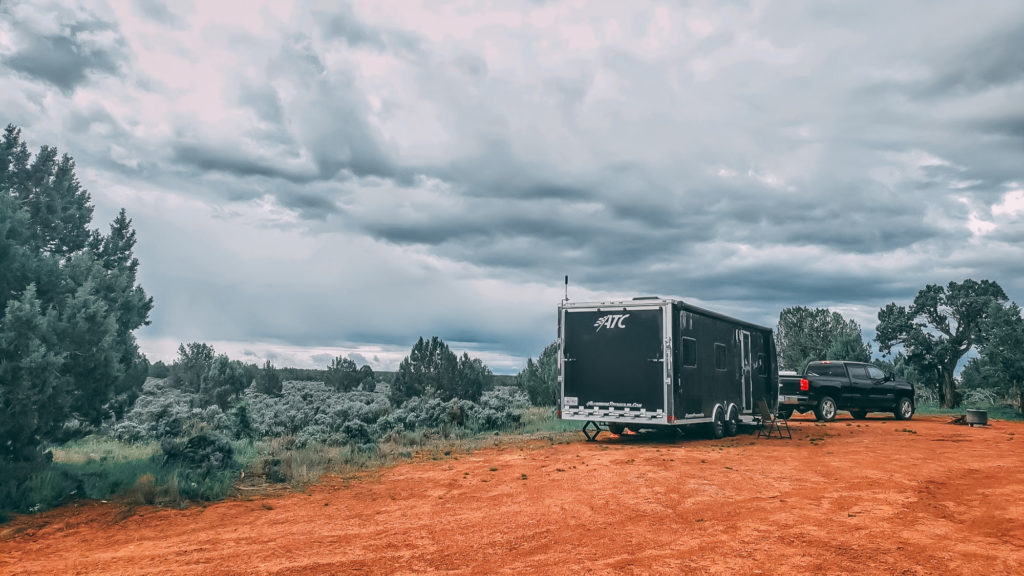You can camp just about anywhere on BLM land. The Bureau of Land Management controls 245 million acres of land and nearly all of it is free for camping. Most of it requires no reservations, no permission. Just pull up and set up. But like with everything else, there are some exceptions.

Where Can You Camp on BLM Land?
The BLM has four major categories of lands…
Open Lands
Open lands carry no special designation. These are open, public lands often usually without signage marking your entrance. These are the lands most boondockers refer to when describing BLM camping. These lands also account for up to 80% of all BLM lands. There are some cases where the BLM has leased some of these lands to mining companies, oil drilling companies, timber companies. In these cases, you will see fencing and/or roads with construction crews.
Otherwise, you are free to set up camp on open land, but only under the following circumstances…
- You must drive on established roads, dirt roads, and trails. You are not allowed to drive your vehicle off-road.
- Camping is permitted in areas that were previously used for camping, as evidenced by cleared land with tire tracks, campfire remains
- You may camp in areas that are free of brush, trees, animal habitats, or archaeological remains
- Do NOT camp within 200 feet of a body of water (river, stream, lake, pond)
- You must respect the privacy and distance of other campers (there is a rule against creating a nuisance).
Note: there are small pockets of open lands that are completely surrounded by private property. You are not allowed to trespass through private property to reach these lands. You must seek permission from the property owner first.
Also, there are cases where open lands extend into city boundaries. In most of these cases, there will be city laws prohibiting camping anywhere except for established RV parks and campgrounds. You cannot camp on these BLM lands.
Developed Recreation Areas
These lands come with some level of development specifically for recreational use.
Most OHV (Off-highway vehicle) areas fall into this category. Typically at an OHV area, there will be a staging area where campers and toy haulers will set up, and then a larger area set aside strictly for vehicular use. Generally, you can camp anywhere in the staging area. See the BLM rules for Off-Road Vehicles.
Developed campgrounds (usually defined by the presence of picnic tables, fire rings, pit toilets, information kiosk, camp host, fee collection boxes, etc…) require that you camp only in marked sites. Very few BLM developed campground accept fees and reservations. Long Term Visitor Areas (LTVAs) are some of the few developed areas that require fees. You can find all of the BLM’s developed campgrounds at their website here.
Developed Recreation Areas also include day use-only areas such as picnic grounds, trail heads, wildlife viewing decks, etc. You cannot camp at these areas.
National Conservation Lands
These are primarily the National Monuments, such as Canyons of the Ancients National Monument in Colorado, Grand Staircase Escalante National Monument in Utah, Mojave Trails National Monument in California and many others. But they also include “National Conservation Areas”, “National Scenic and Historic Trails”, and “Wild and Scenic Rivers”.
Dispersed camping and boondocking is generally permitted on these lands, and for the most part is handled the same way as with open lands. However, each National Monument, Conservation Area, Trails, and Rivers are autonomous from each other, and are permitted to create their own rules. In some cases, you may have to obtain a camping permit (which are usually free), or may be limited to camping in designated areas. You’ll have to check with the visitor center.
Wilderness Areas
Wilderness Areas technically fall under the category of National Conservation Lands above. But, these lands come with more strict rules on camping. Wilderness Areas do not permit motor vehicles. Hence, only tent camping is permitted. Most Wilderness Areas have a parking lot located just outside of the Wilderness boundary. You will have to park your vehicle there and hike your camping gear in.
Many RVers and vanners have parked their rigs at the parking lot and camped overnight, or for several nights. Often times, these parking lots are not patrolled. You are not allowed to park overnight in these parking lots.
Many Wilderness Areas will have a dirt road that either circumnavigates the perimeter. Generally, this road is considered Public Land, can you can camp off of it, provided you are not blocking traffic and that your vehicle does not cross over into Wilderness. In some cases, a Wilderness Area will have a dirt road that splits through it. Again, the road itself, along with a 8-10 foot buffer on either side, remains Public Land. You can camp off of this road, but not beyond the Wilderness Area boundary.
See the full set of rules on camping in Wilderness Areas.
BLM Camping Maps
The Bureau of Land Management publishes a wide variety of maps for all states. Many of these are recreational maps that show where popular campgrounds are located. To find these maps, read “BLM Land Maps, Where to Find Them“.
Summary
Where can you camp on BLM Land? Just about anywhere. For the most part, if you see a fence and gate blocking your access, you can’t camp there. If all you are private roads leading into some BLM lands, you cannot drive through there. Otherwise, you are free to camp on most BLM lands.


Your article on BLM camping states that most BLM developed campgrounds do not accept fees. “Very few BLM developed campground accept fees …”. This is contradicted by the BLM.gov site linked on the same page. It states: “Permits, Fees and Limitations: Most BLM campgrounds require a fee to use a campground.” See links.
https://www.boondockersbible.com/knowledgebase/where-can-i-camp-on-blm-land/
https://www.blm.gov/programs/recreation/camping